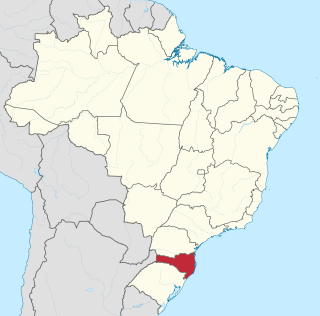
Paraná is one of the 26 states of Brazil, in the south of the country. It is bordered in the north by São Paulo state, in the east by the Atlantic Ocean, in the south by Santa Catarina state and the province of Misiones, Argentina, and in the west by Mato Grosso do Sul and Paraguay, with the Paraná River as its western boundary. It is subdivided into 399 municipalities, and its capital is the city of Curitiba. Other major cities are Londrina, Maringá, Ponta Grossa, Cascavel, São José dos Pinhais and Foz do Iguaçu. The state is home to 5.4% of the Brazilian population and generates 6.2% of the Brazilian GDP.

Santa Catarina is one of the 27 federative units of Brazil. It is located in the centre of the country's Southern region. It is bordered to the north by the state of Paraná, to the south by the state of Rio Grande do Sul, to the east by the Atlantic Ocean, and to the west by the Argentine province of Misiones.

Florianópolis is the capital and second largest city of the state of Santa Catarina, in the South region of Brazil. The city encompasses Santa Catarina Island and surrounding small islands, as well as part of the mainland. It has a population of 537,211, according to the 2022 Brazilian census, the second-most populous city in the state, and the 39th in Brazil. The metropolitan area has an estimated population of 1,111,702, the 21st largest in the country. The city is known for having the country's third highest Human Development Index score among all Brazilian cities (0.847).

The Fluminense Federal University is a Brazilian public higher education institution located mainly in Niterói and in other cities of Rio de Janeiro state. It was first established on December 18, 1960, with the name of Universidade Federal do Estado do Rio de Janeiro (UFERJ), through an integration of different academic colleges in the city of Niterói. On November 5, 1965, the current name became official.

Chapecó is a municipality in the state of Santa Catarina, in the Southern Region of Brazil. Being a major industrial, financial and educational center, it is a major producer of industrialized food products. Considered a medium city, with a population estimated at 224,013 inhabitants, it is among the four most important cities in the state. It belongs to the Meso-region of Western Santa Catarina and to the Microregion of Chapecó.

The Federal University of Santa Maria is a Brazilian public university located in Santa Maria, in the state of Rio Grande do Sul, funded by the federal government of Brazil. It was founded in 1960, by Professor José Mariano da Rocha Filho. Its campuses span over 1,837.72 ha, with a total of 386,968 m2 of buildings and 28,307 students.

The Federal University of Santa Catarina is a public university in Florianópolis, the capital city of Santa Catarina in southern Brazil.

Avaí Futebol Clube is a Brazilian football team from Florianópolis in Santa Catarina, founded on 1 September 1923. Their home stadium is Estádio Aderbal Ramos da Silva, also known as Ressacada, with a capacity of 17,800. They play in blue and white shirts, shorts and socks.

Joinville is the largest city in Santa Catarina, in the Southern Region of Brazil. It is the third largest municipality in the southern region of Brazil, after the much larger state capitals of Curitiba and Porto Alegre. Joinville is also a major industrial, financial and commerce center.
The Museu Entomológico Fritz Plaumann is an entomological museum located in Seara, Santa Catarina, Brazil. The museum contains the collections of famed entomologist Fritz Plaumann and is kept by an agreement between the municipal government of Seara, where the entomologist lived, and the Santa Catarina State University (UFSC). It is a relatively small collection, with about 80,000 individuals from 17,000 species, most of them collected by Plaumann himself around the Upper Uruguai river region. The biggest entomological collections in Brazil are the ones from Museu Nacional do Rio de Janeiro, Museu de Zoologia de São Paulo and Universidade Federal do Paraná.
The Prêmio José Reis de Divulgação Científica is an annual honor awarded by the Brazilian Council of Scientific and Technological Development (CNPq) to the institution, media organization, publication, or individual who most contributed to the dissemination and public awareness of science and technology in Brazil. It is thus named in honor of Dr. José Reis, a Brazilian biologist and science writer who was one of the pioneers in the field.

The Amazonas State University is a Brazilian public university operated by the state of Amazonas, located in Manaus, Amazonas, Brazil. It was established in 2001 by a state law that turned the University of Technology of Amazonas into the UEA. In 2011, UEA was ranked the best university of the state in an evaluation made by the Ministry of Education.

Brusque is a city in the state of Santa Catarina, Brazil. It was founded in 1860, by 55 German immigrants.

Camboriú is a municipality in the state of Santa Catarina in the South region of Brazil. It is near Balneario Camboriu, a popular beach destination.

The Universidade Feevale (Feevale) is a Brazilian university in the city of Novo Hamburgo in the metropolitan region of Porto Alegre, Rio Grande do Sul. The selection process is through an entrance exam and continuous assessment.

The Central Zone is an administrative zone of the city of São Paulo, Brazil.

Dodi Tavares Borges Leal is an academic, performer and trans rights activist who, is a professor in performing arts at the Federal University of Southern Bahia (UFSB) and an associate researcher at the State University of Santa Catarina (UDESC). Her 2018 appointment at UFSB meant that she was the first transgender arts professor to take up a permanent employment in public higher education in the world.















